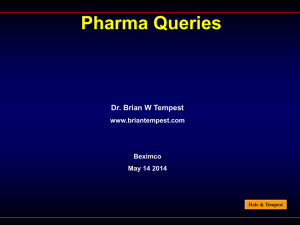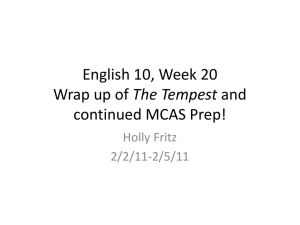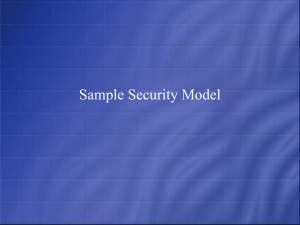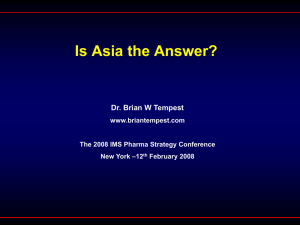Tempest Attacks - The University of Tulsa
advertisement
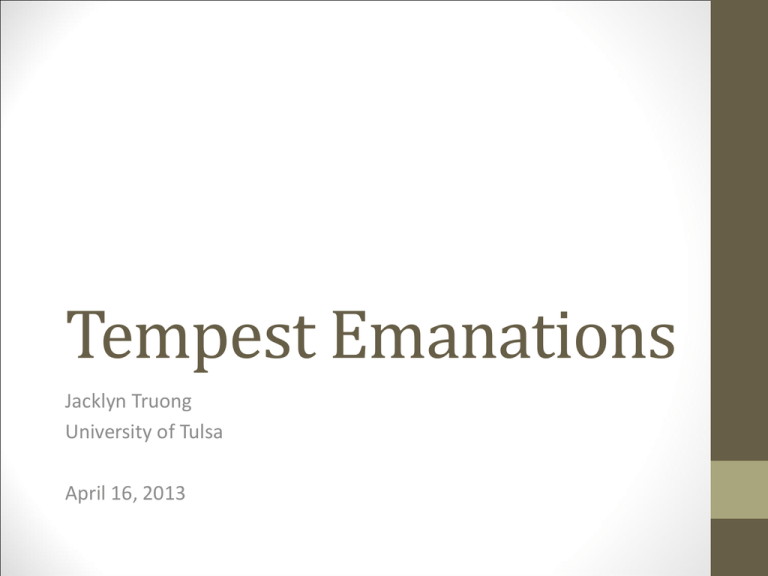
Tempest Emanations Jacklyn Truong University of Tulsa April 16, 2013 Introduction • Tempest emanations • Electromagnetic waves emitted by electric devices • Generated when device changes voltage of an electric current • Can travel extensive distances through free space • Travel distance can be extended by conductors • Can be captured • Tempest attacks • Captured Tempest emanations can be deciphered to uncover processed data History • 1944 – Bell Labs stumble upon Tempest emanations • Bell Labs provided US Military with mixing devices called 131-B2 • Used with a rotor key generator to encrypt messages • Each step of the mixing device caused a frequency pattern to appear on an oscilloscope • Found that the frequency pattern revealed the plaintext of the encrypted messages • Findings reported to the US Military • US Military was skeptical • Bell Labs performed a test to prove threat • Recorded signals from 80 feet away from the Signal Corps’ Varick Street cryptocenter • Produced 75% of the plaintext being processed History • Bell Labs directed to develop suppression methods • Bell Labs’ suppression methods: • Shielding • Prevent Tempest emanations through free space and magnetic fields • Filtering • Prevent compromising emanations from traveling through conductors • Masking • Purposely create electrical noise to drown out compromising emanations History • US Military’s Response • Modified device was bulky and required too much maintenance • Established control zones • 100 feet in diameter • Ended research on Tempest emanations History • 1951 – CIA rediscovered the 131-B2 and Tempest emanations • NSA picked up project in an attempt to find new suppression methods • 1953 – Policy required all US cryptocenters to either: • Establish a control zone, 400 feet in diameter • Implement masking • Apply for a waiver based on operational necessity • 1954 – Soviets published a set of standards for the suppression of radio frequency interference History • 1960 – British intelligence agency accidently discovered Tempest emanations in a similar manner to Bell Lab’s discovery • 1985 – Wim van Eck published a paper demonstrating how contents from a CRT could be extracted using low-cost equipment • First major public description of Tempest emanations • Van Eck phreaking Executing a Tempest Attack • Use a wide-band receiver tuned to a specific frequency 1. Determine what frequency to be listening in on • Scan entire frequency range and extract plaintext of emanation according to its amplitude/frequency modulation 2. Improve signal-to-noise ratio • Use narrow-band antennas and filters 3. Intercept emanations and deduce plaintext Present-Day Tempest Attacks • CRT Monitors • Electron beam strikes screen at various intensities to generate different pixels • The electric signal that drives the electron beam emits Tempest emanations • Pixels updated one at a time • LCD Monitors • • • • Pixels updated row by row No deflection coils – low radiation Operate on low voltages Still vulnerable • DVI cable • Configurations Present-Day Tempest Attacks • Keyboards • Each keystroke causes the voltage of the electric current being sent to the computer to change • Tempest Viruses • Theoretical (Ross J. Anderson) • Infiltrate machine and automatically transmit retrieved information to a hidden radio receiver nearby Tempest Emanations and Businesses • Tempest Emanations • Difficult to suppress • Surpasses advanced encryption algorithms • The business environment consists of many electronic devices emitting Tempest emanations • Sensitive information at risk • • • • • Personal information Financial information Customer information Login information Encryption/decryption keys Mitigation • Modify devices • 1955 – NSA modified teletypewriters to transmit character data all at once • Resulted in one large (oscilloscope) “spike” per character instead of five • Reduce voltage • Weaker emanations • Soft Tempest Font • • • • Markus Kuhn and Ross Anderson Free Minimize strength of compromising emanations Readable on a computer monitor, but not across Tempest emanations Mitigation • Soft Tempest Font Mitigation • Shield • Individual machines • Faraday cage • • • • Apply filters Mask – drown out emanations by generating electrical noise Physically separate machines (classified and unclassified) Encrypt signal being sent • HDCP – High bandwidth Digital Content Protection • LCD Monitors • Lower refresh rate Conclusion • Initially very difficult to suppress • Some methods are expensive • Modifying devices • Faraday cages • Physically separating machines • Moving forward • Encrypt signal being sent References • [1] D. G. Boak, “A History of U.S. Communications Security,” NSA, Ft. George G. Meade, MD, Rep. MDR-54498, 1973, vol. 1 and 2. • [2] M. G. Kuhn and R. J. Anderson, D. Aucsmith, "Soft tempest: Hidden data transmission using electromagnetic emanations", Information Hiding: 2nd Int. Workshop, vol. 1525, pp.124 -142 1998 :Springer-Verlag • [3] M. Pellegrini. (2008, April 29). Declassified NSA Document Reveals the Secret History of TEMPEST [Online]. Available: http://www.wired.com/threatlevel/2008/04/nsa-releases-se/ • [4] B. Koops, The Crypto Controversy: A Key Conflict in the Information Society, Kluwer Law International, 1999, pp. 211. • [5] R. Anderson, Security Engineering: A Guide to Building Dependable Distributed Systems, Wiley Computer Publishing, New York, 2001, pp. 538-539. • [6] Dynamic Sciences International, Inc. (2012). R-1550A TEMPEST Receiver [Online]. Available: http://www.dynamicsciences.com/client/show_product/33 • [7] M. Vuagnoux and S. Pasini. "Compromising electromagnetic emanations of wired and wireless keyboards," In proceedings of the 18th USENIX Security Symposium, pages 1-16, Montreal, Canada, 2009. USENIX Association. • [8] J. Loughry and D. A. Umphress. Information leakage from optical emanation. ACM Transactions on Information and Systems Security, 5(3):262-289, 2002. • [9] Introni (2012). La Crittografia [Online]. Available: http://www.introni.it/crittografia.html Questions?

